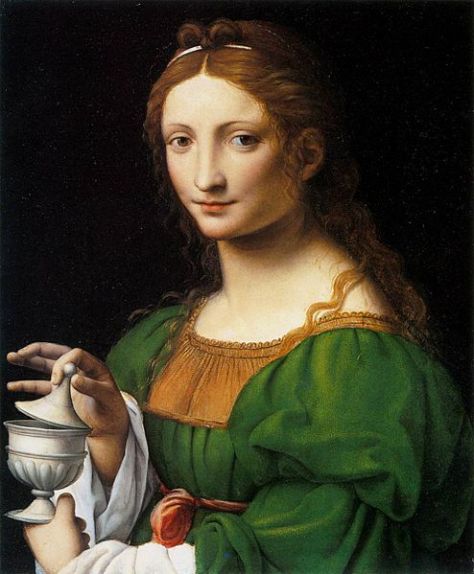
St Mary Magdalen and St Catherine of Alexandria, Simone Martini,1320-25
Fresco, 215 x 185 cm
Cappella di San Martino, Lower Church, San Francesco, Assisi.
While he was at Bethany in the house of Simon the leper, as he sat at the table, a woman came with an alabaster jar of very costly ointment of nard, and she broke open the jar and poured the ointment on his head. But some were there who said to one another in anger, “Why was the ointment wasted in this way? For this ointment could have been sold for more than three hundred denarii, and the money given to the poor.” And they scolded her. But Jesus said, “Let her alone; why do you trouble her? She has performed a good service for me. For you always have the poor with you, and you can show kindness to them whenever you wish; but you will not always have me. She has done what she could; she has anointed my body beforehand for its burial. Truly I tell you, wherever the good news is proclaimed in the whole world, what she has done will be told in remembrance of her.”
Mark 14:3-9
I am currently taking part in a weekly women’s retreat series based upon the book, Do What You Have the Power to Do by Helen Bruch Pearson. The book contains six studies of women from the New Testament who are nameless but who take some action that involves Jesus. This week we read and meditated on the woman with the alabaster jar. Her story is told in varying ways in all four of the Gospels, but there is some confusion surrounding her identity. She has been conflated with Mary Magdalene, who has also become confused with the “woman of ill repute” in Luke’s version. Our task for the retreat was to read Mark’s account at least three times, each time noting what words or phrases stood out to us, and then praying and journaling further on them.

Mary Magdalene by Bernardino Luini, 1520-25, oil on panel, 59 cm x 48 cm, National Gallery, Washington DC.
As an art historian who has always had a special appreciation for ancient alabaster vessels, my first thought was, “Why did she have to break the jar?”

Greek Alabaster Alabastrons or Perfume Flasks, Ionia 425-400 BC (left) Greek 575-550 BC (right).
Photo: Kurt Buzurd, Traveltoeat.com
The obvious answer is, to release the precious ointment. Perhaps it had thickened so that it wouldn’t pour easily. In order to perform her act of service for Jesus, she had to break the vessel. Sometimes things that seem valuable to us may need to be broken in order to get to the truly precious things hiding inside them.

Mary Magdalene by Frederick Sandys, ca. 1858–60, Oil on panel, 33.5 cm × 28 cm, Delaware Art Museum, Wilmington, Delaware.
This led me to ask myself, what jar in my life needs to be broken so that I have the power to do what I need to do?
Is the jar my expectations? Personal relations? Isolation?
Is the vessel that needs to be broken my heart?
If I break open the jar, will the precious ointment flow?
The ointment of love…of healing…of spiritual rebirth…of resurrection?
What is inside your alabaster jar?

Dear Jane, Infinite Windows – Meditations are ‘Art and Faith’….is a terrific site. I really appreciate your willingness to share your knowledge of Art and your generosity of time and spirit to put your meditative thoughts down on ‘paper’. *Thank you so much* –
Pierrette L (Montreal)
LikeLiked by 1 person
I appreciate your kind comments, thanks so much!
LikeLike
Hi Jane! your post is so clever and I love your insights at the end… I’d say that probably the jar in our lives that needs to be broken is the jar of expectations… I think that we are happier when we put them aside and just try to live as life goes, accepting our flaws and restrictions as we try to spotlight our strengths.
I didn’t know that the jar needed to be broken in order to release the precious ointment. That’s certainly a powerful detail which emphasizes the main message of your post. ⭐
All my bets wishes to you! Happy weekend. Aquileana 😉
LikeLiked by 1 person
I love that idea of letting go of expectations! Thank you for that!
LikeLike
[…] 10. Woman with the Alabaster Jar […]
LikeLike